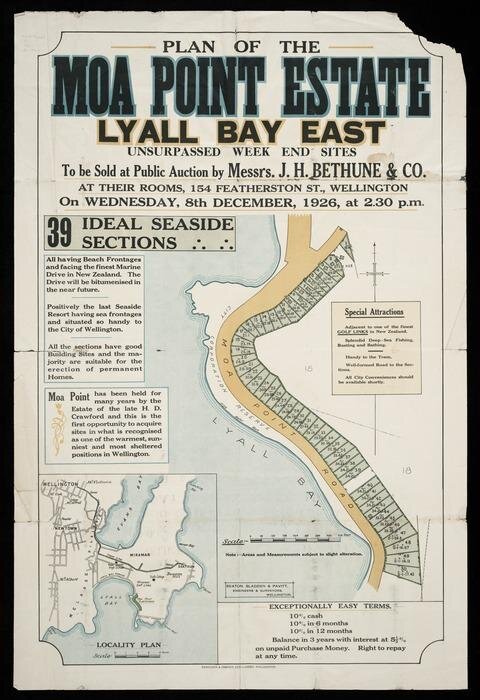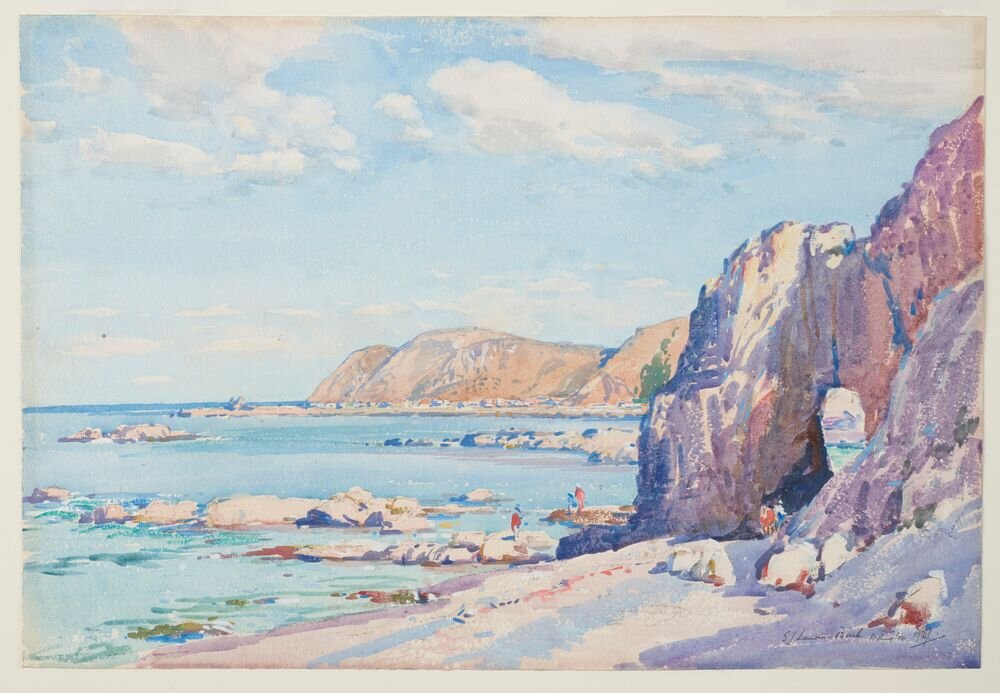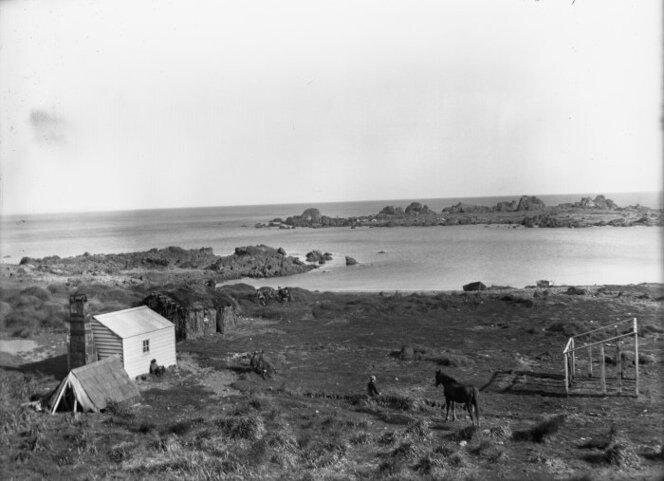
Breaker Bay & Moa Point History
From their wild beginnings both Moa Point and Breaker Bay have been a draw for artists. If you would like to see your art featured here send us an email!
Click on a photo to see the originating institution
Marten Youngs Recollections of building the Breaker Bay Hall.
I clearly remember my father John (Jack) Young along with others, one of whom I thought was Ravenscroft building the hall. The building was done in their spare time and there wasn’t much of that! Most of the building was done during the war years so it took quite a time. It was always during the weekends that there was work on the hall. At the time I was around eight years old and already Dad had given me a hammer and other tools along with home maintenance responsibilities. I was enlisted to help with laboring work at the hall such as digging the foundations and wall footings. My mother Ethyl used to prepare lunches, and I was the delivery boy! I didn’t think anything of running from 189 to the hall as I was used to walking to Seatoun. That was 2 miles each way.'
I was to young to remember the building details but recall that the site always looked very untidy. This was strange to me as Dad was meticulous and demanded the same care from me. By comparison the building of our house was very orderly. Now with years of experience I have come to understand that volunteer work tends to be messy and disorganised in comparison with a professionally operated site. It was after the war that my father trained as a builder and turned professional.
The hall took shape and involved many Breaker Bay people. Soon the kitchen area was ready to be roofed. The bitumen (tar) was heated and broomed over the sarking. The malthoid was rolled out and bore tar was used to seal the overlaps. Gravel from Tarakena Bay was used to seal the overlaps. There was a pill box opposite where 194 is now. This had a barrier arm across the road and the co-operation of the Army was required to get the gravel. The main roof was corrugated asbestos and this lasted until quite recently when the mathoid roof was replaced 50 plus years ago. The heavy stucco plaster walls have stood the test of sun, sea and wind and are still good now. Of course there have been many volunteer hours spent applying paint. We used to use a product called ‘Sonwcem’ a white cement. This has been superseded by modern paint. The window frames and sahses were standard state house design the same used in the houses being built in Strathmore at this time.
As most of the work was during the war years, all metal was really scarce. Timber was used and the spouting and down pipes were boxed out of heart totara. They were all cut by hand including the weather grooves. Totara has to have special priming, this was a combination of red led, a no today as its considered deadly poisonous. Hot dipped galvanised nails were difficult to find and they had a habit of falling of trucks near state housing building sites. The gas and water pipes were galvanised steel and the wastes were 100% lead. All the framing was sawn rimu and interior linings were Pinex hard board, while the ceiling was standard Pinex, Pines would never be used today, it was a fire hazard. When it was all finished everyone was very proud of it. It looked so smart.
Whanga-nui-a-Tara (Wellington Harbour) towards Raukawa Moana (Cook Strait) from Breaker Bay. Michael Hall; photographer; 2002; Wellington
This hangs in Breaker Bay Hall! “@SeanDG : 1926: Plan of the Moa Point estate, Lyall Bay east
Breaker Bay. Leslie Adkin; photographer; 12 November 1949
Breaker Bay. Samuel Birch; artist; 1937; New Zealand
1855 raised beach at Eve Bay. Breaker Bay, Point Dorset and harbour entrance beyond. Leslie Adkin; photographer; 30 July 1919
1889 View of beach at Moa Pt. Original site of outer pilot station
Group with two automobiles and a motorcycle sidecar combination at a barrier across the road at Breaker Bay, Wellington, photographed in 1923 by S C Smith of Wellington.
New Rongotai Airport : Moa Point from reef. Leslie Adkin; photographer; 12 July 1953
[Haylock, Arthur Lagden] 1860-1948 :[Pencarrow Head & L House 1916]. A view from the Wellington side of the harbour entrance, possibly Breaker Bay, with a woman with a parasol standing on the beach. In the distance is Pencarrow Head with the lighthouse prominent at the top of the cliffs. A ship and a yacht are passing through the heads and Barrett's Reef is visible
Breaker Bay, Wellington, 1923
Breaker Bay, Wellington [ca 1880s-1890s]
View of Breaker Bay, looking west from below the Pass of Branda, taken in the 1890s or 1900s by Daniel Manders Beere.
White Bell Bus Company sightseeing bus on the Pass of Branda, overlooking Breaker Bay, photographed by Mr Just between the 1st of June 1929 and the 31st of May 1930. The ship in the background is probaly the `Tamahine'. Note the tram lines on the beach. Note on back of file print reads "Registration: 94-502 (therefore from 1 June 1929 - 31 May 1930)"
Crowd at Point Dorset, Seatoun, watching the floating dock being pulled in to Wellington, 1931. Photograph taken by Sydney Charles Smith.
Unidentified workmen at the Pass of Branda, moving shingle from the Crawford's Quarry to Wellington, circa 1908. Photographer unidentified.
Unidentified workmen at the Pass of Branda, moving shingle from the Crawford's Quarry to Wellington, 1909. Photographer unidentified.
Palmer Head and the entrance to Wellington Harbour with Tarakena Bay and Moa Point Road, with Miramar Peninsula and Breaker Bay beyond, Wellington City [21 Mar 1956]. Aerial photograph taken by Whites Aviation.
Moa Point, Wellington, circa 1950s. Taken by an unidentified photographer.
At Moa Point, Wellington, circa 1926. Taken by an unidentified photographer. Note on back of file print reads: "Relief works. 1926. New Marine Parade between Lyall & Breaker Bay."
A unit of the New Zealand artillery at work with large guns at Fort Dorset, Seatoun, Wellington. Photograph taken in April 1937. This photograph appeared in the Evening Post on 17/4/1937, with the caption: "Looking across the gun emplacements when a unit of the New Zealand artillery was at work with the big guns"
Military personnel training at Fort Dorset in Wellington. Photographed by S C Smith in 1937.
Palmer Road Hill Climb, Breaker Bay, Wellington. Photographs taken ca 1964 by Bruce Valentine Davis.
Rongotai, Wellington [12 Dec 1947]. Aerial photograph taken by Whites Aviation. (includes Moa Point, bottom right)
Aerial view of Rongotai and Moa Point, Wellington [1955]. Photograph taken for the Evening Post newspaper of Wellington by an unidentified staff photographer.
Breaker Bay [1974]
Image of Rona Bailey taken by her daughter Meg Bailey around Breaker Bay area in Wellington, New Zealand in March 1963. By Meg Bailey - Meg Bailey the copyright holder of this image has given us permission to upload to Wikimedia Commons., CC BY 4.0, https://commons.wikimedia.org/w/index.php?curid=95312619
Breaker Bay from Pass of Branda [24 June 1959]
At Breaker Bay - 11 Jan 1960. Demolishing the Salt Works building In the days before Breaker Bay Rd, the Paewhenua Kainga settlement was situated on the hill
Breaker Bay residents take penguin protection into their own hands. Stuff, Sep 16 2015
This section of road is between Moa Point and Breaker Bay, Wellington and I so love it, something special about the lay of the land and just the flow of everything.
A Postcard From Miramar - postcards from the collection of Barry Cash. Breaker Bay #1
A Postcard From Miramar - postcards from the collection of Barry Cash. Breaker Bay #2
A Postcard From Miramar - postcards from the collection of Barry Cash. Breaker Bay #3
A Postcard From Miramar - postcards from the collection of Barry Cash. Breaker Bay #4
Other photos of Breaker Bay and Moa Point
Instagram
Flickr
Mike Riversdale, photo albums
If you are a local photographer and would like to showcase your Breaker Bay and/or Moa Point photographs please don’t hesitate to drop us a line - bbmppa.secretary@gmail.com








![[Haylock, Arthur Lagden] 1860-1948 :[Pencarrow Head & L House 1916]. A view from the Wellington side of the harbour entrance, possibly Breaker Bay, with a woman with a parasol standing on the beach. In the distance is Pencarrow Head with the lighthou](https://images.squarespace-cdn.com/content/v1/5f863c49a182ec5937a2bd02/c417d655-9fe1-430f-9c15-a216331e710a/mini_magick20210721-1-17r5qk3.jpg)

![Breaker Bay, Wellington [ca 1880s-1890s]](https://images.squarespace-cdn.com/content/v1/5f863c49a182ec5937a2bd02/d574f92b-75b7-477d-9b2a-6ddde13c806b/mini_magick20210721-1-9l6ldy.jpg)





![Palmer Head and the entrance to Wellington Harbour with Tarakena Bay and Moa Point Road, with Miramar Peninsula and Breaker Bay beyond, Wellington City [21 Mar 1956]. Aerial photograph taken by Whites Aviation.](https://images.squarespace-cdn.com/content/v1/5f863c49a182ec5937a2bd02/a3214593-873f-4dcc-b393-e24c163d68ca/mini_magick20210721-1-1hlf1ob.jpg)





![Rongotai, Wellington [12 Dec 1947]. Aerial photograph taken by Whites Aviation.
(includes Moa Point, bottom right)](https://images.squarespace-cdn.com/content/v1/5f863c49a182ec5937a2bd02/33c28b63-08e8-4b4c-b5c8-ce98c17f58e0/mini_magick20210721-1-1ueme0m.jpg)
![Aerial view of Rongotai and Moa Point, Wellington [1955]. Photograph taken for the Evening Post newspaper of Wellington by an unidentified staff photographer.](https://images.squarespace-cdn.com/content/v1/5f863c49a182ec5937a2bd02/131a4701-faa5-4132-bba1-504447348dab/mini_magick20210721-1-1o0ljxd.jpg)
![Breaker Bay [1974]](https://images.squarespace-cdn.com/content/v1/5f863c49a182ec5937a2bd02/a6782ccb-93e8-4c3b-bffe-afb1723dda28/DKacxhGVoAIbVSj.jpeg)

![Breaker Bay from Pass of Branda [24 June 1959]](https://images.squarespace-cdn.com/content/v1/5f863c49a182ec5937a2bd02/96c3d271-7df3-4431-b671-ff2ef6f4ceea/97269736_2978747235546861_7435130555982675968_n.jpg)






